
If you’re looking for a sushi that’s sweet, savory, and fun, then the mango roll is for you. This beautiful roll is both delicious and nutritious. In addition, it doesn’t contain any raw fish so it may be an easier sell to Western pallets.

Table of Contents
What is a Mango Sushi Roll?
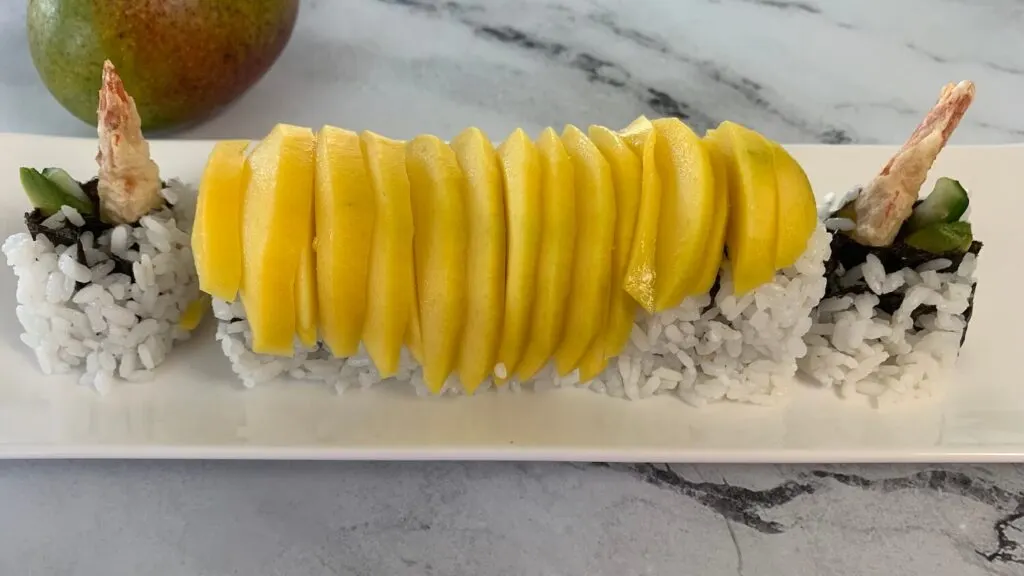
A mango roll is essentially a shrimp tempura roll with a sweet mango sauce and slices of mango draped over the top of the roll. The sweet flavor of the mango combines well with the savory shrimp tempura to make a delicious roll. I usually serve this roll with a ramekin of sweet mango sauce. However, you could also serve with unagi sauce or soy sauce.
How to Control the Thickness of Your Rolls
You can control how thick your sushi rolls are by how much of the nori sheet you use. I prefer to use an entire nori sheet for mango rolls because the mango that we drape over the top of the roll fits better over a larger roll.
If you like thinner rolls you can use 2/3 or 1/2 of the nori sheet. However, this would be more difficult to roll and the mango that is draped over the top of the roll may not fit as well.
How to Make Mango Sushi Rolls
The trick to making mango rolls is to use ripe mangos as they will form to the roll easier and have a sweeter flavor. Below we walk you through how to make these beautiful rolls step-by-step.
Cook Sushi Rice
1. Rinse 1 1/3 cups of sushi rice by placing it into a colander and running water through it until the water is clear.

2. After the rice is rinsed, add it to a sauce pan with 1 2/3 cups of water. Be sure to check the packaging of your rice to see exactly how much water to use as each brand may differ slightly.

3. Bring the water to a boil and then reduce the heat to low. Cover and let the rice simmer for 20 to 30 minutes, or until the water is absorbed and the rice is soft.

4. Remove the rice and place it into a bowl or dish. I would line the dish with parchment paper prior to adding the rice to avoid sticking.

5. Mix 1/4 cup of sushi vinegar into your rice. Stir until the vinegar has absorbed into the rice. Once cooled and fully absorbed, your rice is ready to roll!

Prepare Sweet Mango Sauce
1. Peel and cut the mangos into cubes and add to them to the blender. I would use riper mangos as they will be sweeter.

2. Squeeze the juice from a lemon into the blender and add 1/4 cup of sugar.
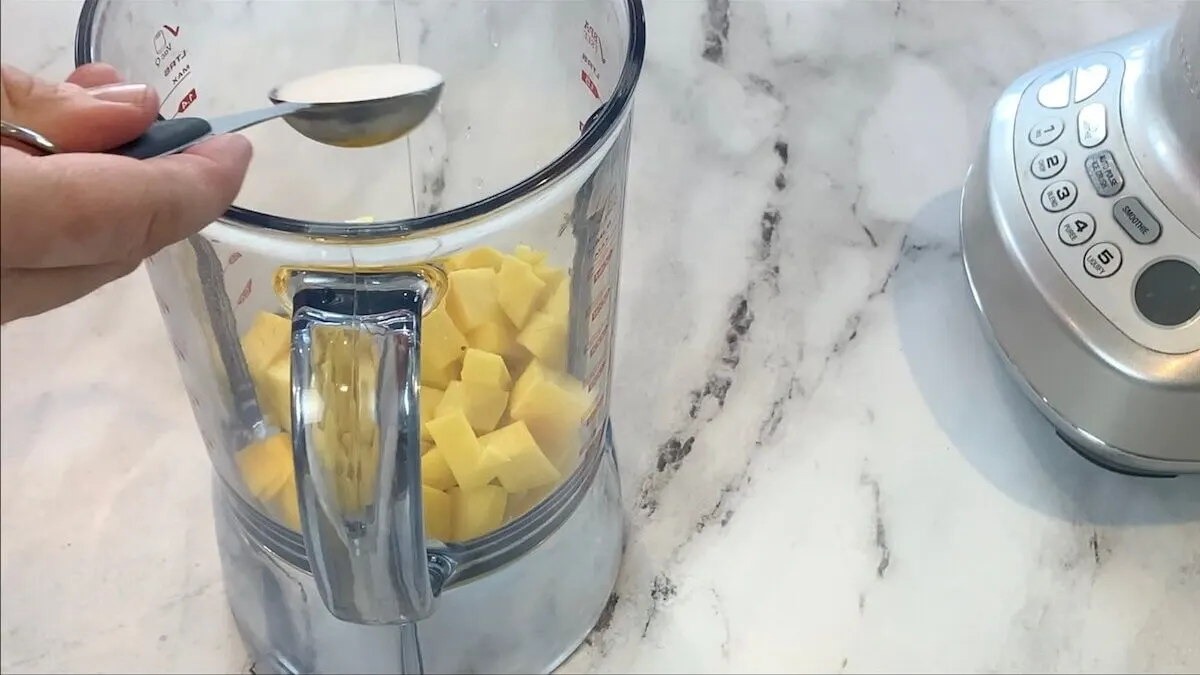
3. Blend the mixture on the highest setting for 30-45 seconds.

Prepare shrimp
1. In a sauce pan, heat 6 cups of vegetable oil on medium heat to 350 degrees.

2. Remove the shells from shrimp, leaving the tails on. Remove the spiky part of the tail closest to the back as that can pop when frying.
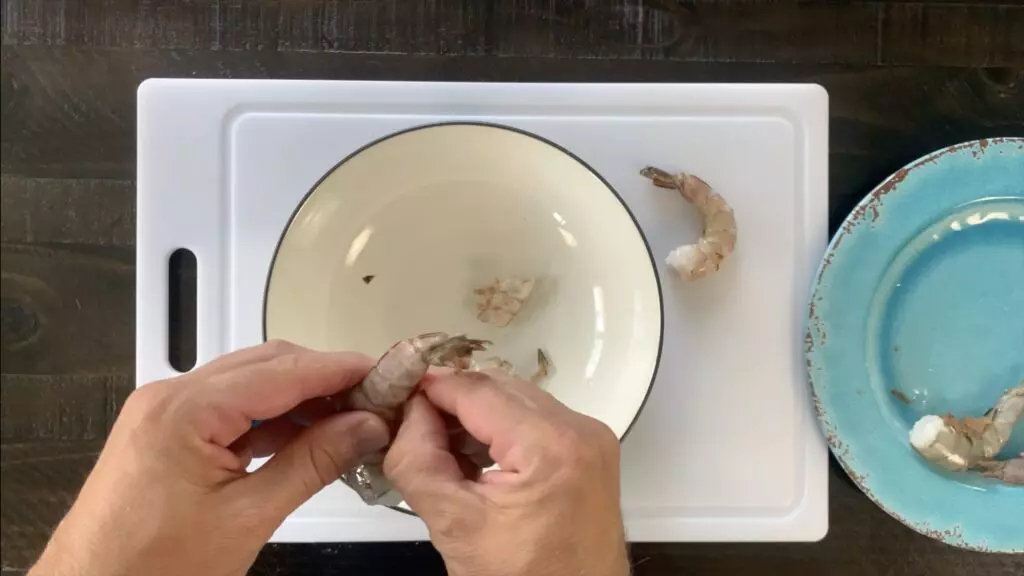
3. Use a sharp knife to cut along the back of the shrimp about 1/4 of the way through to expose the vein. Once exposed, remove the vein.

4. Use your knife to scrape the black liquid out of the tail. This can also cause the shrimp to pop during frying.

5. Rinse the shrimp thoroughly and dry with a paper towel.
6. Stretch the shrimp so it will be straight after you fry it. You can do this by using a sharp knife to make shallow cuts along the belly of shrimp from the head to the tail. Then use your fingers to press the shrimp against the cutting board, straightening the shrimp. You should hear cracking as you press down.

7. Put the remaining cup of flour into a plate or small bowl and dip the shrimp into the flour making sure the entire piece of shrimp is coated in flour. This helps the batter to stick to the shrimp.

Prepare Tempura Batter and cook the shrimp
1. Assemble the ingredients and chill the water. You may need to add ice if you don’t have access to very cold water. However, make sure to remove ice cubes before combining with egg.
2. Crack the egg into a mixing bowl and beat until the yolk and white are combined.

3. Add cold water to the egg and mix well. I like to strain ice water directly into the bowl. This assures that the water is ice cold.

4. Add one cup of sifted flour to the egg and water combination. I usually sift the flour directly into the bowl to ensure the flour is fluffy.

5. Using a spoon or chopstick, lightly mix making sure not to over stir. The batter should be mixed but a little lumpy.

6. Holding by the tail, dip each piece of shrimp into the batter ensuring the piece is evenly coated. Then gently drop the batter into the vegetable oil, cooking for around two minutes, or until the batter is golden brown and the shrimp is cooked through. Once done, place on a plate covered with two or three paper towels to help soak up any excess oil. Repeat this process for all shrimp.

7. Discard the remaining oil when complete.
Assemble the Mango Rolls
1. Prepare your bamboo sushi mat: Cover your bamboo sushi mat with plastic wrap. This will help keep the rice from sticking to it.
2. Cut the cucumber: Cut the cucumbers into strips that are as long as your nori sheet and about 1/8 inch thick.
3. Press rice onto nori sheets: Next, place the nori sheet onto the plastic wrap with the shiny side facing down. Then press around 1 cup of rice onto the nori sheet in an even layer. Tip: Wet your hands prior to handling the sushi rice. This will prevent the rice from sticking to your hands.

5. Flip nori sheet: Flip the nori sheet so the rice is facing down.

4. Add sweet mango sauce: Add a thin line of sweet mango sauce to the roll prior to adding the other fillings.
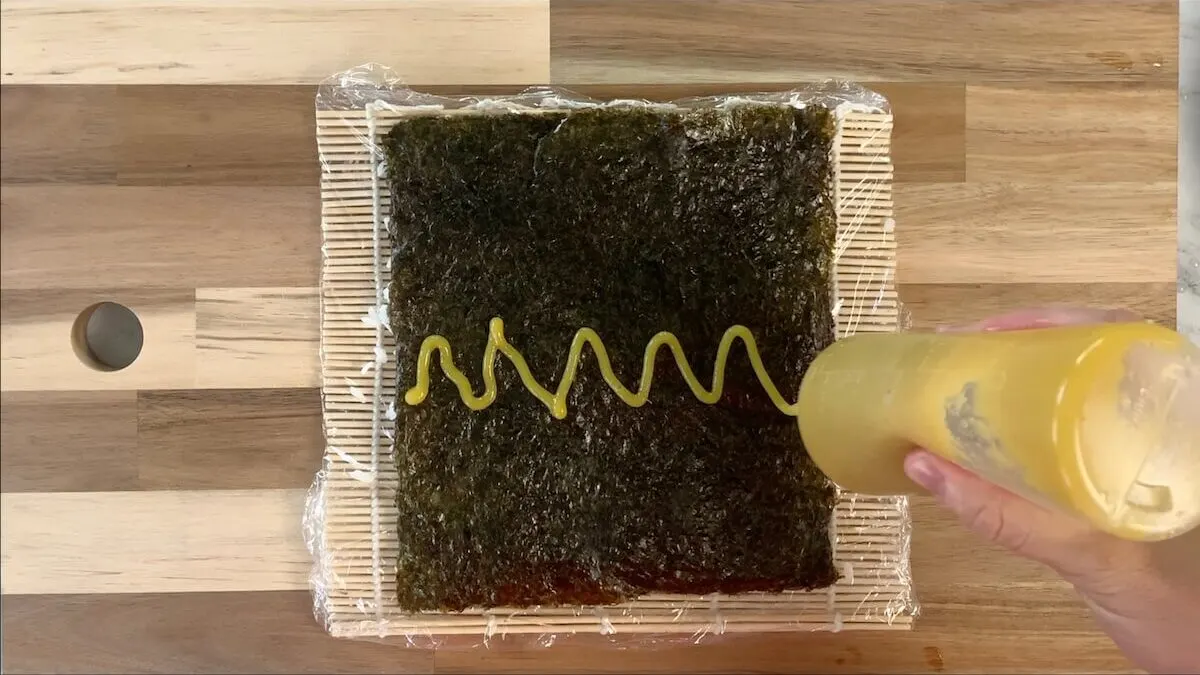
5. Cut the avocado: Slice the avocado in half the long way. Remove the seed and cut each half into 6 slices. The whole avocado should yield around 12 slices. I often cut the slices right out of the avocado half and add directly to the roll to ensure freshness. You can also drizzle lemon juice over your cut avocado to prevent it from browning in your roll.
6. Add the avocado and cucumber: Add the avocado slices and cucumber sticks horizontally along the nori sheet. In general, I add 2-3 avocado slices and 1-2 cucumber sticks depending on the size of each ingredient and how everything fits.

7. Add the shrimp: Add two pieces of shrimp to the middle of the roll with the tails sticking out of each end.

8. Roll the sushi: Use the bamboo sushi mat to fold your roll until it’s completely enclosed. Once the rice is making contact with the nori sheet, pull back the sushi mat so it doesn’t get caught in the roll. Still using the sushi mat as your guide, finish rolling until it’s completely wrapped. Then wrap the sushi mat around the roll and firmly press the roll together. Keep in mind that rolling sushi is an art that may take some practice so don’t get frustrated if it doesn’t look perfect your first time. It will get easier the more you do it.
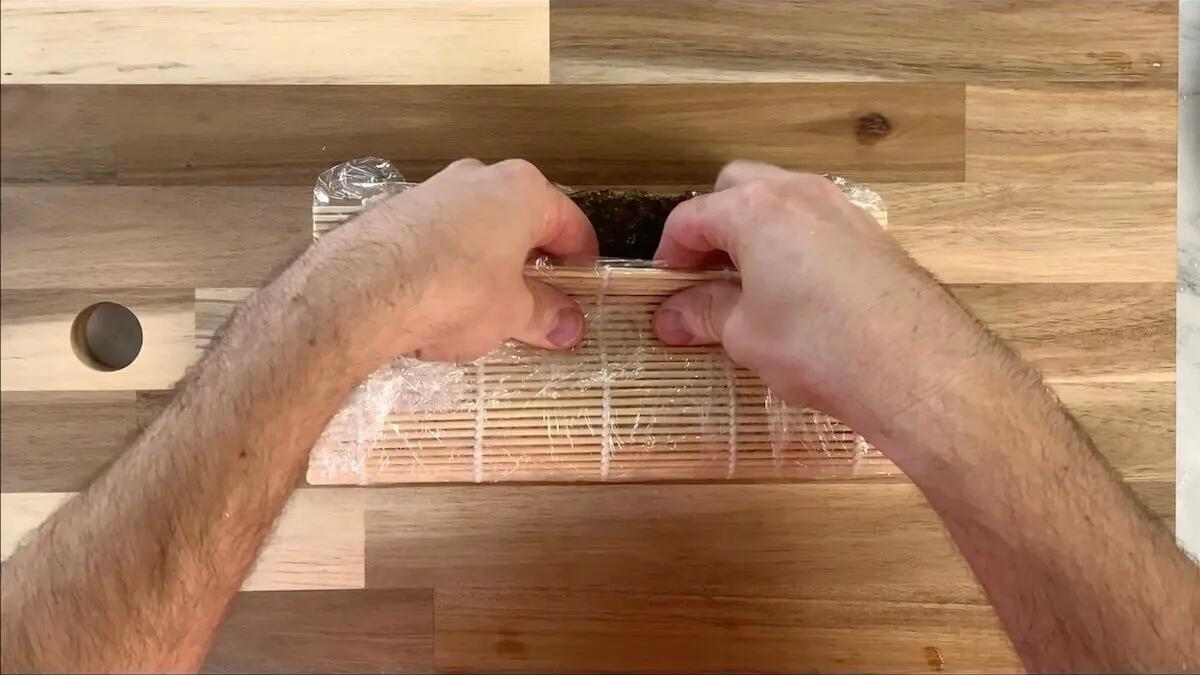
9. Cut the mango and add to the roll: The remaining mango needs to be peeled and cut into fourths. Each fourth then needs to be sliced thinly and added to the top of each roll. To do this, I start by pealing the entire mango and cutting into four sections around the core. I then cut each fourth into thin slices going the short way. Cut the slices as thin as you can or around 1-2 millimeters thick. Once cut, use your hand to gently push the mango slices to the side so they fold over on top of each other. Then place all the slices of one fourth of the mango on top of your roll. Tip: It helps to use a ripe mango for this step as it will be softer and form to the sushi roll better.

10. Use the bamboo sushi mat to press the mango slices onto the roll: Since the mango slices have a tendency to move around, I would suggest covering the roll in plastic first. Then wrap the sushi mat around the roll and firmly press the mat onto the roll, forming the mango slices to the top of the roll. Leave the plastic on the roll for cutting.

11. Cut the roll: Using a sharp knife, cut the roll into 8 pieces through the plastic wrap. I do this by first cutting the roll in half. Then I cut each half in half. I then cut each fourth in half. This should give you 8 pieces that are equal size. Once done cutting, remove the plastic from each of the pieces. Tip: Be sure to clean and wet the edge of your knife before cutting each roll. This will prevent the roll from sticking to your knife.

12. Optional: Lightly drizzle with sweet mango sauce over the top of the mango slices.
13. Serve and enjoy: I usually serve with sweet mango sauce or unagi sauce.
Mango Sushi Roll Recipe

Mango Roll Sushi Recipe
Equipment
- 1 Bamboo Sushi Mat
- 1 Pot for cooking sushi rice
- 1 Pot for frying tempura batter
- 1 Sharp knife and cutting board
Ingredients
Sushi Rice
- 1 1/3 cups Sushi Rice dried, will cook to 4 cups
- 4 cup Sushi Vinegar
Sweet Mango Sauce
- 2 Mangos
- 1 Lemon
- 1/4 Cup Sugar
Tempura Batter
- 6 cups Vegetable oil
- 2 cups All purpose flour
- 1 Egg Large
- 1 cup Water Ice cold
Roll and Filling
- 4 Nori Sheets
- 1 Ripe Avocado
- 1 English Cucumber Sliced into 1/8 sticks
- 8 Pieces Shrimp Size – 13 to 15 per pound
- 1 Mango
Instructions
Cook Sushi Rice
- Rinse 1 1/3 cups of sushi rice by placing it in a colander and running water through it until the water is clear.
- After the rice is rinsed, add it to a sauce pan with 1 2/3 cups of water. Be sure to check the packaging of your rice to see exactly how much water to use as each brand may differ slightly.
- Bring the water to a boil and then reduce the heat to low. Cover and let the rice simmer for 20 to 30 minutes, or until the water is absorbed and the rice is soft.
- Remove the rice and place into a bowl or dish. I would line the dish with parchment paper prior to adding the rice to avoid sticking.
- Mix 1/4 cup of sushi vinegar into your rice. Stir until the vinegar has absorbed into the rice. Once cooled and fully absorbed, your rice is ready to roll!
Prepare Sweet Mango Sauce
- Cut the mangos into cubes around the core and add them to the blender. I would use riper mangos as they will be sweeter.
- Squeeze the juice from a lemon into the blender and add the sugar.
- Blend on the highest setting for 30-45 seconds.
Prepare shrimp
- In a sauce pan, heat 6 cups of vegetable oil on medium heat to 350 degrees.
- Remove shells from shrimp, leaving the tails on. Remove the spiky part of the tail closest to the back as that can pop when frying.
- Use a sharp knife to cut along the back of the shrimp about 1/4 of the way through to expose the vein. Once exposed, remove the vein.
- Use your knife to scrape the black liquid out of the tail. This can also cause the shrimp to pop during frying.
- Rinse the shrimp thoroughly and dry with a paper towel.
- Stretch the shrimp by using a sharp knife to make shallow cuts along the belly of shrimp from the head to the tail. Then use your fingers to press the shrimp against the cutting board, straightening the shrimp. You should hear cracking as you press down.
- Put the remaining cup of flour into a plate or small bowl and dip the shrimp into the flour making sure the entire piece of shrimp is coated in flour. This helps the batter to stick to the shrimp.
Prepare Tempura Batter and cook the shrimp
- Assemble the ingredients and chill the water. You may need to add ice if you don't have access to very cold water. However, make sure to remove ice cubes before combining with egg.
- Crack the egg into a mixing bowl and beat until the yolk and white are combined.
- Add cold water to the egg and mix well. I like to strain ice water directly into the bowl. This assures that the water is ice cold.
- Add one cup of sifted flour to the egg and water combination. I usually sift the flour directly into the bowl to ensure the flour is fluffy.
- Using a spoon or chopstick, lightly mix making sure not to over stir. The batter should be mixed but a little lumpy.
- Holding by the tail, dip each piece of shrimp into the batter ensuring the piece is evenly coated. Then gently drop the batter into the hot vegetable oil, cooking for around two minutes, or until the batter is golden brown and the shrimp is cooked through. Once done, place on a plate covered with two or three paper towels to help soak up any excess oil. Repeat this process for all shrimp.
- Discard the remaining oil when complete.
Assemble the Mango Rolls
- Prepare your bamboo sushi mat: Cover your bamboo sushi mat with plastic wrap. This will help keep the rice from sticking to it.
- Cut the cucumber: Cut the cucumber into strips that are as long as your nori sheet and about 1/8 inch thick.
- Press rice onto nori sheets: Next, place the nori sheet onto the plastic wrap with the shiny side facing down. Then press around 1 cup of rice onto the nori sheet in an even layer. Tip: Wet your hands prior to handling the sushi rice. This will prevent the rice from sticking to your hands.
- Flip nori sheet: Flip the nori sheet so the rice is facing down.
- Add sweet mango sauce: Add a thin line of sweet mango sauce to the roll prior to adding the other fillings.
- Cut the avocado: Slice the avocado in half the long way. Remove the seed and cut each half into 6 slices. The whole avocado should yield around 12 slices. I often cut the slices right out of the avocado half and add directly to the roll to ensure freshness. You can also drizzle lemon juice over your cut avocado to prevent it from browning in your roll.
- Add the avocado and cucumber: Add the avocado slices and cucumber sticks horizontally along the nori sheet. In general, I add 2-3 avocado slices and 1-2 cucumber sticks depending on the size of each ingredient and how everything fits.
- Add the shrimp: Add two pieces of shrimp to the middle of the roll with the tails sticking out of each end.
- Roll the sushi: Use the bamboo sushi mat to fold your roll until it's completely enclosed. Once the rice is making contact with the nori sheet, pull back the sushi mat so it doesn't get caught in the roll. Still using the sushi mat as your guide, finish rolling until it's completely wrapped. Then wrap the sushi mat around the roll and gently tighten the roll together. Keep in mind that rolling sushi is an art that may take some practice so don’t get frustrated if it doesn’t look perfect your first time. It will get easier the more you do it.
- Cut the mango and add to the roll: The remaining mango needs to be peeled and cut into fourths. Each fourth then needs to be sliced thinly and added to the top of each roll. To do this, I start by pealing the entire mango and cutting into four sections around the core. I then cut each fourth into thin slices going the short way. Cut the slices as thin as you can or around 1-2 millimeters thick. Once cut, use your hand to gently push the mango slices to the side so they fold over on top of each other. Then place all the slices of one fourth of the mango on top of your roll. Tip: It helps to use a ripe mango for this step as it will be softer and form to the sushi roll better.
- Use the bamboo sushi mat to press the mango slices onto the roll: Since the mango slices have a tendency to move around, I would suggest covering the roll in plastic first. Then wrap the sushi mat around the roll and firmly press the mat onto the roll, forming the mango slices to the top of the roll. Leave the plastic on the roll for cutting.
- Cut the roll: Using a sharp knife, cut the roll into 8 pieces through the plastic wrap. I do this by first cutting the roll in half. Then I cut each half in half. I then cut each fourth in half. This should give you 8 pieces that are equal size. Once done cutting, remove the plastic from each of the pieces. Tip: Be sure to clean and wet the edge of your knife before cutting each roll. This will prevent the roll from sticking to your knife.
- Optional: Lightly drizzle with sweet mango sauce over the top of the mango slices.
- Serve and enjoy: I usually serve with sweet mango sauce or unagi sauce.
Video
Notes
- You can control how thick your sushi rolls are by how much of the nori sheet you use. This recipe uses the entire nori sheet which makes thicker rolls. If you like smaller rolls, you can cut the nori sheet in half. This will definitely make the roll thinner and easier to eat with chopsticks but it can be trickier to roll. You can also cut off the top 1/4 of the nori sheet to reduce the thickness of the roll depending on your preference.
- I always prepare the shrimp and heat the oil before mixing the tempura batter to make sure the batter is good and cold when you cook. You should begin cooking your shrimp immediately after mixing the batter.
- Make sure you dry the shrimp well prior to frying or else it will pop in the oil.
Nutrition
Frequently Asked Questions
Is a mango roll cooked?
Yes. There are no raw fish or meats in the mango roll. The primary protein in the mango roll is shrimp tempura, which is cooked.
Is a mango roll gluten-free?
If ordered from a restaurant, the mango roll will likely contain gluten as shrimp tempura normally contains gluten. However, mango rolls can easily be made gluten-free by substituting the flour in the shrimp tempura with a gluten-free alternative.
Final Thoughts on Mango Sushi Rolls
Mango rolls are the perfect sushi for a hot day! I love the complementary flavors that the shrimp tempura and mango bring to this roll. I hope you enjoy this roll as much as I do! Happy cooking!
For more fun recipes, check out the below articles:
Unagi Don (Eel Rice Bowl) Recipe
Unagi (Eel) Rolls: Step-by-Step Recipe
Also, subscribe to our YouTube Channel for some great videos!

Robert Schaffart
Monday 24th of June 2024
Love this recipe!